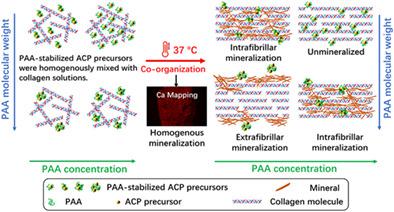当前位置:
X-MOL 学术
›
Polym. Compos.
›
论文详情
Our official English website, www.x-mol.net, welcomes your
feedback! (Note: you will need to create a separate account there.)
Molecular weight and concentration of poly (acrylic acid) dual-responsive homogeneous and intrafibrillar collagen mineralization using an in situ co-organization strategy
Polymer Composites ( IF 4.8 ) Pub Date : 2021-06-07 , DOI: 10.1002/pc.26161 Lirui Shen 1 , Honghong Bu 2 , Yuanzhi Zhang 1 , Pingping Tang 2 , Guoying Li 1
Polymer Composites ( IF 4.8 ) Pub Date : 2021-06-07 , DOI: 10.1002/pc.26161 Lirui Shen 1 , Honghong Bu 2 , Yuanzhi Zhang 1 , Pingping Tang 2 , Guoying Li 1
Affiliation

|
Intrafibrillar mineralization is crucial in the synthesis of collagen-hydroxyapatite (HAP) composites with hierarchical structure resembling natural bone. The polymer-induced liquid precursor method, which involves immersing the matrix into polymer-stabilized amorphous calcium phosphate (ACP) solutions, has been widely used to regulate collagen mineralization; however, heterogeneous infiltration and crystallization of ACP precursors from the surface to the inner matrix remain a concern. In this study, the polymer-mediated co-organization strategy in which poly (acrylic acid) (PAA)-stabilized ACP solutions were initially introduced to collagen solutions before sol–gel transformation was employed to achieve homogeneous mineralization. Moreover, the effects of PAA with various molecular weights (2, 10, and 450 kDa) and concentrations (40, 80, and 120 mg/L) on collagen mineralization were evaluated. Increasing concentration and decreasing molecular weight both improved the stability of ACP precursors, which affected collagen mineralization. A lower concentration (40 mg/L) of 2 kDa PAA and higher concentration (80 and 120 mg/L) of 100 and 450 kDa PAA effectively retarded ACP crystallization, thereby inducing intrafibrillar mineralization. Extremely unstable ACP precursors failed to infiltrate the interior of fibrils using 100 and 450 kDa of PAA at 40 mg/L, resulting in extrafibrillar mineralization. Inversely, collagen fibrils were unmineralized until 7 days owing to excessive stability of ACP precursors using 2 kDa of PAA at higher concentrations. The present results further explain the mechanisms of intrafibrillar mineralization, and may provide a facile method for producing biomimetic materials.
中文翻译:

使用原位协同组织策略的聚(丙烯酸)双响应均质和纤维内胶原矿化的分子量和浓度
纤维内矿化对于合成具有类似于天然骨骼的分层结构的胶原-羟基磷灰石 (HAP) 复合材料至关重要。聚合物诱导的液体前体方法,包括将基质浸入聚合物稳定的无定形磷酸钙 (ACP) 溶液中,已被广泛用于调节胶原矿化;然而,ACP 前体从表面到内部基质的异质渗透和结晶仍然是一个问题。在这项研究中,聚合物介导的共组织策略,其中聚(丙烯酸)(PAA)稳定的 ACP 溶液最初被引入到胶原溶液中,然后采用溶胶-凝胶转化来实现均匀矿化。此外,不同分子量(2、10 和 450 kDa)和浓度(40、80、和 120 毫克/升)对胶原矿化的影响进行了评估。增加浓度和降低分子量都提高了 ACP 前体的稳定性,从而影响了胶原蛋白的矿化。较低浓度 (40 mg/L) 的 2 kDa PAA 和较高浓度 (80 和 120 mg/L) 的 100 和 450 kDa PAA 有效地延缓了 ACP 结晶,从而诱导纤维内矿化。使用 100 和 450 kDa 40 mg/L 的 PAA 时,极不稳定的 ACP 前体未能渗透到原纤维内部,导致纤维外矿化。相反,由于 ACP 前体在较高浓度下使用 2 kDa 的 PAA 的过度稳定性,胶原纤维直到 7 天才被矿化。目前的结果进一步解释了纤维内矿化的机制,
更新日期:2021-06-07
中文翻译:

使用原位协同组织策略的聚(丙烯酸)双响应均质和纤维内胶原矿化的分子量和浓度
纤维内矿化对于合成具有类似于天然骨骼的分层结构的胶原-羟基磷灰石 (HAP) 复合材料至关重要。聚合物诱导的液体前体方法,包括将基质浸入聚合物稳定的无定形磷酸钙 (ACP) 溶液中,已被广泛用于调节胶原矿化;然而,ACP 前体从表面到内部基质的异质渗透和结晶仍然是一个问题。在这项研究中,聚合物介导的共组织策略,其中聚(丙烯酸)(PAA)稳定的 ACP 溶液最初被引入到胶原溶液中,然后采用溶胶-凝胶转化来实现均匀矿化。此外,不同分子量(2、10 和 450 kDa)和浓度(40、80、和 120 毫克/升)对胶原矿化的影响进行了评估。增加浓度和降低分子量都提高了 ACP 前体的稳定性,从而影响了胶原蛋白的矿化。较低浓度 (40 mg/L) 的 2 kDa PAA 和较高浓度 (80 和 120 mg/L) 的 100 和 450 kDa PAA 有效地延缓了 ACP 结晶,从而诱导纤维内矿化。使用 100 和 450 kDa 40 mg/L 的 PAA 时,极不稳定的 ACP 前体未能渗透到原纤维内部,导致纤维外矿化。相反,由于 ACP 前体在较高浓度下使用 2 kDa 的 PAA 的过度稳定性,胶原纤维直到 7 天才被矿化。目前的结果进一步解释了纤维内矿化的机制,


















































 京公网安备 11010802027423号
京公网安备 11010802027423号